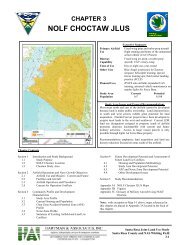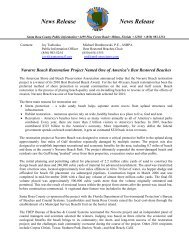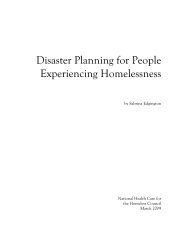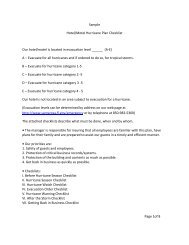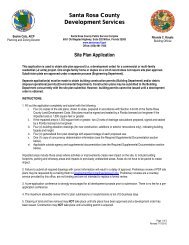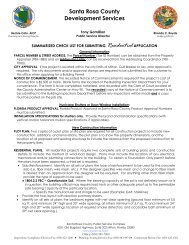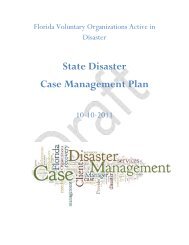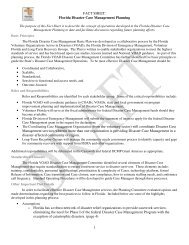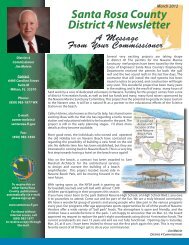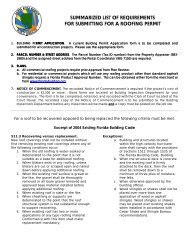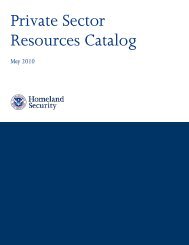Disaster - Santa Rosa County
Disaster - Santa Rosa County
Disaster - Santa Rosa County
Create successful ePaper yourself
Turn your PDF publications into a flip-book with our unique Google optimized e-Paper software.
Get a Kit!<br />
All Americans should have some basic supplies on hand<br />
in order to survive for at least three days if an emergency<br />
occurs. To the left is a check list of some basic items that<br />
every emergency supply kit should include. However, it<br />
is important that individuals review this list and consider<br />
where they live and the unique needs of their family in<br />
order to create an emergency supply kit that will meet these<br />
needs. Individuals should also consider having at least two<br />
emergency supply kits, one full kit at home and smaller<br />
portable kits in their workplace, vehicle or other places they<br />
spend time.<br />
10<br />
<strong>Disaster</strong> Kits<br />
<br />
Water, one gallon of water per person per day for at<br />
least three days, for drinking and sanitation<br />
<br />
Food, at least a three-day supply of non-perishable food<br />
<br />
Battery-powered or hand crank radio and a NOAA<br />
Weather Radio with tone alert, extra batteries for both<br />
<br />
Flashlight and extra batteries<br />
<br />
First aid kit<br />
<br />
Whistle to signal for help<br />
<br />
Dust mask, to help filter contaminated air, plastic<br />
sheeting and duct tape to shelter-in-place<br />
<br />
Moist towelettes, garbage bags and plastic ties for<br />
personal sanitation<br />
<br />
Wrench or pliers to turn off utilities<br />
<br />
Can opener for food (if kit contains canned food)<br />
<br />
Local maps<br />
<br />
Cell phone and chargers<br />
<br />
Prescription medications and glasses<br />
<br />
Infant formula and diapers<br />
<br />
Pet supplies (see page 11 for pet disaster kit items)<br />
<br />
Important family documents such as copies of<br />
insurance policies, identification and bank account<br />
records in a waterproof, portable container<br />
<br />
Cash or traveler’s checks and change<br />
<br />
Emergency reference material such as a first aid book<br />
or this disaster guide<br />
<br />
Sleeping bag or warm blanket for each person.<br />
Consider additional bedding if you live in a cold<br />
weather climate. Complete change of clothing<br />
including a long sleeved shirt, long pants and sturdy<br />
shoes. Consider additional clothing if you live in a<br />
cold weather climate.<br />
<br />
Household chlorine bleach and medicine dropper for<br />
disinfecting water (see page 20). Do not use scented,<br />
color safe or bleaches with added cleaners.<br />
<br />
Fire extinguisher<br />
<br />
Matches in a waterproof container<br />
<br />
Personal hygiene items<br />
<br />
Mess kits, paper cups, plates and plastic utensils, paper<br />
towels<br />
<br />
Paper and pencil<br />
<br />
Books, games, puzzles or other activities for children<br />
- Ready.gov<br />
Home<br />
Work<br />
Car<br />
This is your main disaster supplies kit and should<br />
contain essential food, water, and supplies for<br />
at least three days. Keep this kit in a desig nated<br />
place and have it ready in case you have to leave<br />
your home quickly. Make sure all family members<br />
know where the kit is kept. Additionally, you may<br />
want to consider having supplies for sheltering<br />
for up to two weeks.<br />
This kit should be in one container, and ready to<br />
“grab and go” in case you are evacuated from<br />
your workplace. Make sure you have food and<br />
water in the kit. Also, be sure to have com fortable<br />
walking shoes at your workplace in case an<br />
evacuation requires walking long distances.<br />
In case you are strand ed, keep a kit of emer gency<br />
supplies in your car. This kit should contain food,<br />
water, first aid supplies, flares, jumper cables,<br />
and seasonal supplies.<br />
Check your kits!<br />
Go Paperless<br />
Scan and store copies of<br />
your important documents<br />
and save on CDs, flash<br />
drives or external backup<br />
devices.<br />
Review the supplies in your disaster kits at least once<br />
a year, and replace items which may have expired or<br />
become unusable.




